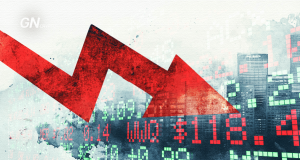A World of Crypto – The 2024 Geography of Crypto Report

The 2024 Geography of Crypto Report reveals how digital currencies are reshaping global finance. Take a journey through different regions to understand why crypto is both a luxury and a lifeline around the world.
Well, here we are in 2024, and crypto has officially gone global.
It’s almost hard to believe: what started as a bold experiment with Bitcoin has transformed into a financial powerhouse that’s reshaping economies around the world. These days, there’s over a $2.45 trillion circulating in cryptocurrencies and digital assets of all couleur—crypto’s not some side project anymore; it’s everywhere, woven right into mainstream economies, legal systems, and, let’s be honest, maybe even your aunt’s investment portfolio.
Our friends over at Chainalysis just dropped their 2024 Geography of Crypto Report, and it’s a goldmine of insights. They’ve taken a good, hard look at how different regions are embracing crypto and why.
This isn’t just about the U.S. and Europe; it’s a worldwide analysis.
The report breaks down how different regions around the world are interacting with crypto. Driven by factors ranging from political instability and inflation to institutional enthusiasm and technological innovation, we can see new rules for crypto-assets in the EU, China and it’s People’s Bank of China (PBOC) banning crypto enterprises from operating in the country, and countries like El Salvador adopting Bitcoin as legal currency and tender.
From India’s unexpected top spot in grassroots adoption to North America’s heavy hitters in institutional investment, this report paints a complex picture of the modern crypto ecosystem.
What’s happening with crypto isn’t just about money; it’s about power, influence, and resilience in a world where traditional finance can’t keep up. So, let’s dive into this report, unpack the findings, and take a journey through crypto’s global playground—who’s in, who’s out, and why.
A New World Map: Global Cryptocurrency Adoption 2024
So, at the core of the 2024 Geography of Crypto Report is something called the Global Cryptocurrency Adoption Index. This ranking isn’t just a numbers game. It’s a full-on evaluation of how deeply crypto has made its mark across countries and regions, not just by transaction volume but by actual economic impact. Essentially, it’s a look at how much crypto is moving the needle.
Global distribution of cryptocurrency ownership 2024, Source: Triple A
Made up of four sub-indexes, each of which is based on countries’ usage of different types of cryptocurrency services, their index ranks 151 countries with specific sub-data. They then rank characteristics like population size and purchasing power together with the economic mean of each country to normalize into a final number on a scale of 0 to 1.
The closer the country’s final score is to 1, the higher the rank.
Easy-peasy.
And here’s the twist for all you western crypto nerds: Central & Southern Asia and Oceania (CSAO) are coming out on top.
Seven out of the top 20 countries for crypto adoption are from this region, with India, Indonesia, and Vietnam leading the pack. And when we say leading, we mean India has snatched the number one spot globally.
Leaders of The 2024 Global Crypto Adoption Index ranking Source: Chainalysis
Surprising?
Maybe, but it starts to make sense when you consider the situation on the ground. India’s crypto rise is largely grassroots, powered by folks who need alternatives to the conventional banking system. Even with a hefty 30% tax on crypto gains, Indians are getting into decentralized finance (DeFi) in a big way, seeking a path around high taxes and tight regulations.
Meanwhile, Eastern Europe and Sub-Saharan Africa tell their own tales of crypto adoption. For these regions, crypto isn’t just a tech trend or an investment; it’s a lifeline.
Political instability and inflation are real problems in countries like Ukraine and Nigeria. Traditional currency just doesn’t cut it for many people here. In these places, crypto isn’t just “another option” — it’s the only safe place to stash value when everything else feels up in the air.
Then we shift to the U.S. and U.K., where crypto adoption is a different story entirely. Here, it’s all about big institutional money.
Heavyweights like BlackRock and Fidelity are joining the crypto game, pushing North America to the top in terms of high-value transactions. Take the study Gaining Ground: How Institutional Investors Plan to Approach Digital Assets in 2024 by EY-Parthenon. It found that a solid 94% of the 277 institutional investors surveyed see long-term value in blockchain and digital assets.
Blockchain and digital assets are the new reality for institutions. Source: EY-Parthenon
Even more interesting?
79% consider them essential for diversifying their portfolios. In other words, the big players aren’t just curious about crypto—they’re betting on it.
What does this tell us?
In wealthy regions, crypto’s turning into a new asset class for the elite, while in lower-income areas, it’s becoming a real solution to financial insecurity.
So, as we break it down by region, keep this in mind: crypto means wildly different things depending on where you are. For some, it’s an investment; for others, it’s a necessity. Either way, it’s changing the financial landscape faster than any of us could have predicted.
And the most interesting thing about this whole analysis is that you can also correlate it with the adoption and regulation of AI, as in artificial intelligence.
The future for each crypto and AI has essentially two routes: either the West, especially the European Union, keeps over-regulating and gets left behind, or the rest of the world under-regulates and runs into deep trouble.
North America: From Volatility to Institutional Dominance
North America, specifically the U.S., has a starring role in today’s crypto ecosystem, accounting for almost 22.5% of global crypto activity.
North American users receive almost a quarter of all cryptocurrency. Source: Chainalysis
What’s driving that?
Big money.
Institutional investors have their hands all over this, with roughly 70% of transactions in the million-dollar range. North America’s crypto game isn’t about everyday users—it's dominated by financial titans looking for profit and stability after the FTX fallout of late 2022.
Cryptocurrency is now not just a speculative gamble anymore.
It is now becoming an integral part of mainstream finance in the U.S.
In 2024, the U.S. gave crypto a major boost by introducing Bitcoin exchange-traded products (ETPs), which has thrown open the doors for institutional investment. If there were ever a sign that crypto’s growing up, this is it. Bitcoin ETPs allow traditional investors to jump into crypto without the hassle of wallets, exchanges, or fears about security.
It’s a way for them to dip their toes into the crypto pool without fully getting wet. And let’s be real, this was all the nudge big players like BlackRock and Goldman Sachs needed to dive in headfirst.
The result?
Bitcoin spiked to over $73,000 in March and again in October 2024, igniting interest in other cryptocurrencies like Ethereum as well. But it’s not just Bitcoin or Ethereum that’s drawing in the institutional crowd. Now, North America’s seeing serious investments in tokenized real-world assets (RWAs), like bonds and real estate, using blockchain technology to boost liquidity and make these assets more accessible.
Yet, the regulatory scene is murky as ever.
While the SEC has approved Bitcoin ETFs/ETPs, broader regulation around stablecoins and DeFi is still up in the air. The U.S. government seems like it’s still figuring out what to make of this digital Wild West. In contrast, Canada has a clearer approach, though even they’ve seen major exchanges exit the market due to the tightening rules.
So, what’s the verdict on North America?
This region is setting the tone for the rest of the world when it comes to institutional adoption, despite the regulatory fog. It’s the hub for big-money innovation, and as it goes, so might go the rest of the world.
Latin America: The Rise of Stablecoins Amidst Economic Uncertainty
Now let’s talk about Latin America, where crypto isn’t just about speculation; it’s about survival. Inflation, devaluation, and financial instability are daily headaches in this region, making crypto—especially stablecoins—a crucial means of financial stability.
In North America, crypto’s mainly an asset class.
But in Latin America?
It’s a lifeboat.
Argentina and Venezuela are at the forefront of stablecoin adoption, and it’s easy to see why. Argentina’s inflation rate of the peso is through the roof—well over 140%. No one wants to watch their hard-earned money lose value that quickly, so they’re turning to USD-pegged stablecoins like USDC and Tether (USDT) to store their cash in something more stable.
Platforms like Bitso and Binance are booming because they allow users to trade pesos for stablecoins, a literal lifeline when the national currency isn’t cutting it.
Monthly trading volume of stablecoins paired with the Argentine peso. Source: Chainalysis
Venezuela’s story is similar but with a twist. The bolívar has been on a downward spiral, but for many Venezuelans, crypto is more than just a way to keep value; it’s a tool to get around strict government controls on foreign currency. Bitcoin and stablecoins are a way out—a method to keep funds safe from the prying eyes of the state.
Transfers in stablecoins dominate over the national currency in Venezuela. Source: Chainalysis
Brazil, Latin America's largest economy, on the other hand, shows a bit of a different picture. After a dip in early 2023, institutional transactions are back on the rise in Brazil. Plus, stablecoins are catching on fast here for cross-border payments, offering a cheaper, faster alternative to traditional remittance services.
Stablecoins pegged to the dollar are becoming a credible solution for millions across Latin America who are tired of watching their money lose value overnight.
In a word, Latin America’s crypto story is driven by a need for economic stability. People here aren’t just dabbling—they’re using stablecoins as a hedge against financial chaos.
Where traditional banking systems fall short, crypto currencies have become a real-world utility for many in this region’s volatile economies.
Eastern Europe: Crypto as a Safe Haven in Times of War
Eastern Europe’s story adds a new layer to crypto adoption. For many people here, crypto isn’t just a speculative play; it’s a way to navigate through war and sanctions. The 2024 Geography of Crypto Report shows how Ukraine and Russia have turned to digital currencies as financial lifelines amidst geopolitical chaos.
In Ukraine, crypto adoption has surged as the war drags on.
Inflation’s high, the hryvnia shaky, and many Ukrainians are looking to Bitcoin and DeFi as safer alternatives. The report notes a noticeable spike in DeFi transactions, showing how people are turning to decentralized finance to protect their assets and move money securely. For many, DeFi offers a level of independence that traditional banking just can’t provide in these conditions.
Russia’s relationship with crypto is complicated.
With sanctions cutting off access to global financial systems, Russians are using crypto to sidestep restrictions. Non-KYC exchanges have become especially popular, letting Russians trade in digital assets with some degree of anonymity. Both retail and institutional transactions in Russia are seeing a boost, as people look for workarounds to the financial restrictions imposed by the West.
Interestingly, Russia’s government is also cozying up to crypto. In 2024, they legalized crypto mining and allowed digital currency payments for international trade. It’s a strategic move, aimed at reducing dependence on the U.S. dollar. For the Kremlin, crypto isn’t just a financial tool; it’s a way to mitigate the economic isolation brought on by sanctions.
In Eastern Europe, crypto is more than an investment; it’s a safeguard in times of crisis. Ukrainians and Russians are showing the world how digital assets can offer stability when traditional finance fails to keep up.
Ukraine and Russia are the leaders in Eastern Europe in terms of the amount of cryptocurrency received. Source: Chainalysis
Asia and Oceania: The New Crypto Powerhouse
If there’s one region to keep an eye on, it’s Central and Southern Asia and Oceania. As mentioned before, seven of the top 20 crypto-adopting countries are right here, including India, Indonesia, and Vietnam. These places are taking the lead in both retail and institutional crypto adoption, turning the region into a global powerhouse for digital assets.
India’s story is especially intriguing.
Despite a sky-high 30% tax on crypto gains, Indians are flocking to DeFi and P2P transactions, especially in rural areas where traditional banking is scarce. For a huge portion of the population, crypto isn’t just another way to invest—it’s a practical alternative to banks. This isn’t a country just dabbling in crypto; it’s embracing it head-on, with or without a friendly regulatory environment.
Indonesia and Vietnam aren’t far behind. Indonesia ranks third globally in crypto adoption, thanks to a booming P2P market and growing institutional interest. Vietnam’s crypto scene is driven by retail users, with people using digital assets as alternatives to traditional banks. Both countries see crypto as a tool for financial inclusion, and local exchanges are thriving as people look for reliable ways to store wealth and make transactions.
Then there’s Singapore!
This financial hub has become Asia’s crypto paradise, thanks to a clear regulatory framework and government-backed blockchain initiatives. The city-state is a hotspot for crypto startups and institutional investors, adding serious weight to the region’s influence in global crypto markets.
Central and Southern Asia’s crypto boom shows us how diverse the motivations for digital assets can be. For many, crypto is a way to send remittances, make cross-border payments, or invest in something more stable than local banks.
This region is proving that when traditional finance falls short, crypto is there to fill the gap.
The Battle for the Future: Regulation and Crypto’s Global Path Forward
Of course, with crypto’s rise, the regulatory spotlight gets brighter. The world’s governments are trying to keep up with crypto, and we’re seeing vastly different approaches.
Europe’s taking the lead with its Markets in Crypto-Assets Regulation (MiCA), which is setting standards for digital assets, stablecoins, and DeFi across the EU. MiCA strikes a balance between innovation and investor protection, which is why crypto companies are increasingly eyeing Europe for regulatory stability. It’s no exaggeration to say that MiCA could set the stage for other countries looking to manage the crypto scene.
The U.S., on the other hand, is a bit of a mess.
The SEC has approved Bitcoin ETFs/ETPs, which is a start, but beyond that, there’s not much clarity. Questions about how to handle stablecoins and DeFi are still up in the air, and the lack of clear guidelines has already driven some major players out of the market.
Binance, for example, has scaled back its U.S. operations, heading for friendlier shores.
In Latin America and Africa, crypto regulations are more patchwork, though Brazil’s making headway. Brazil is pushing for stronger rules, especially around stablecoins, while other Latin American countries are still working out how to handle this new wave of digital assets. In Sub-Saharan Africa, crypto is largely unregulated, but its use for remittances and cross-border transactions is growing fast.
Asia presents a mixed bag.
India’s approach is restrictive, with high taxes and murky regulations pushing some crypto activity underground. Singapore and Hong Kong, however, are embracing digital assets with clear rules aimed at attracting investors and startups. They’re setting the example for how to make crypto work within traditional finance.
In the end, the future of crypto will hinge on these regulatory moves. Governments worldwide are scrambling to create frameworks that balance innovation with control. Whether crypto remains a decentralized frontier or becomes fully integrated into the global financial system will depend on the next few years of regulatory action.
What’s Next for the Crypto World?
Chainalysis findings mirror those of a new Triple A Technologies research paper. According to the State of Cryptocurrency Ownership Worldwide in 2024 report, a whopping 562 million people now own digital currencies—that’s a 34% jump from 420 million in 2023. This means about 6.8% of the global population is into crypto, with ownership skyrocketing at a compound annual growth rate (CAGR) of 99% between 2018 and 2023. In short, crypto’s not just for the tech-savvy anymore; it’s gone mainstream.
Over 560+ Million Cryptocurrency owners worldwide – Source: Triple A
Looking to the future, the 2024 Geography of Crypto Report gives us a roadmap of where crypto could be heading. Central and Southern Asia is leading in grassroots adoption, North America’s locking down institutional interest, and Latin America and Eastern Europe are showing just how practical crypto can be in turbulent times.
The next chapter for crypto is going to involve even more regulation, deeper institutional involvement, and, undoubtedly, new tech developments. Europe’s MiCA framework could lead the charge in showing other regions how to regulate, while the U.S. faces the risk of falling behind with its regulatory indecision.
For crypto to keep growing, it can’t just be about speculation—it needs to offer real-world solutions. Whether it’s fighting inflation in Argentina, sending remittances in the Philippines, or offering financial stability in Ukraine, crypto is proving its worth on a global scale.
This report gives us a look at today’s crypto landscape, but the story’s far from over. The next moves made by governments, institutions, and users alike will shape the crypto world of tomorrow.
The content on The Coinomist is for informational purposes only and should not be interpreted as financial advice. While we strive to provide accurate and up-to-date information, we do not guarantee the accuracy, completeness, or reliability of any content. Neither we accept liability for any errors or omissions in the information provided or for any financial losses incurred as a result of relying on this information. Actions based on this content are at your own risk. Always do your own research and consult a professional. See our Terms, Privacy Policy, and Disclaimers for more details.

































